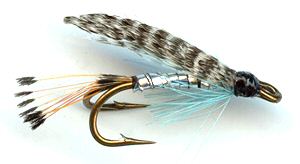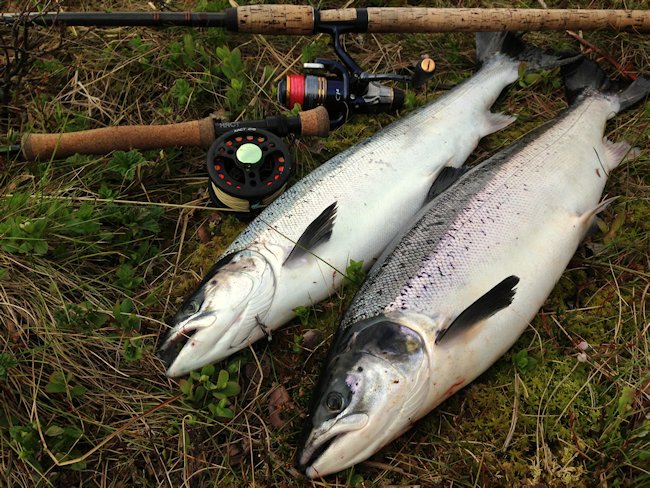Teal Blue and Silver Double Hook Wet Fly
The Teal, Blue and Silver is probably the best river fly for Sea Trout fresh off the tide. Fished as a tail fly it has been taking fish since records began.

DOUBLE HOOKED TROUT AND SALMON FLIES USED IN THE FJORDS OF NORWAY. Hook size 10 12 14 - $US each
Teal Blue and Silver Double Hook Wet Fly is generally accepted to imitate a small herring fry or other such sea prey in its various variants it accounts for many fish each season. Sea trout seem to do what they want, when they want. Trying to understand their behaviour, just like salmon, is fraught with differing confusing theories and conjecture. Sometimes there seems to be no logic to their activities but if you gather as much information as you can you may be able to come to a plan of action. You will find a few fly fishermen who are experts on the sea trout that inhabit their local river but take them on a fishing trip to a different river and their doesn’t seem to work as well in this new environment. They become baffled just like the rest of us.

CUSTOMER'S PHOTO
One salmon was caught on a Silver Wilkinson double hook fly and the other on a Teal Blue and Silver double hook fly by Geir-Vidar Haugen in Northern Norway
Each river has its own peculiarities. Most river brown trout are predictable. They find a lie, carve out an area of operation and stays there waiting for food to drift past. The sea run version of the brown trout is a totally different animal. It does what it wants. If you are planning to go sea trout fishing you need to seek local knowledge or do a lot of planning and reconnaissance. Night time sea trout fishing is much safer executed in the company of other like-minded individuals. It should never be a solo sport as if you get into difficulties no one will see you. Also you need a witness to your great successes to confirm your seatrout catching prowess down the pub. If you do not have any flyfishing friends who think fishing in the dark is great fun then your may have to resort to hiring a guide or joining the local club.
It is sensible to take the time during the day to explore the area you are going to fish at night. That way you reduce the chance of stumbling upon any nasty surprises. Being armed with this information gives you greater confidence when you return during the hours of darkness. I find it amazing how you think you know an area during the day but at night it seems to have changed in character. Extra big boulders seem to growe during the evening. They seem to be designed to trip you up. Well known landmarks and scenery seem to disappear. One of the things I like to do on my daytime visit is to note the width and depth of the river so I can spend the time setting up my tackle. As a good Scout I always make sure I am prepared. It makes for a much more enjoyable evening and stops you constantly casting into rocks and foliage on the opposite river bank.
The main body in the middle of the river is known as the "dub". This is where you will find some of the bigger sea-trout lurk. Leave this area alone until it is completely dark. The deeper side will contain the biggest fish. They are best tackled with larger hook sizes. I like to use a sunken line even in times of low water depths. If you happen to arrive at a sea trout inhabited river very early in the morning in the hope of being present when a dawn hatch is own to cast for brown trout, you might want to try some large streamer flies to this section of the river as you may get some sea trout takes as quite often lurking fish can be found here just before dawn.
The "riffle" is the area of disturbed water that occurs behind a midstream obstruction like a boulder. Some sea trout fly fishermen ignore these locations. If you are fishing near some riffles in late evening you can have some good sport. This is where the smaller sea trout like to hunt for their food. Fish a team of wet flies on hook size 12 or 14 including the Teal Blue and Silver fly pattern.
The throat or pool head is a great area to target with your casts at anytime but I consider it as a late rather than early location to fish. My reasoning is due to the sea trout coming into the lower section on the tide as night descends and exiting from the head at the onset of daylight. But if you have a smallish pool then I normally recommend starting at the head and work your way through. My tactic is to fish for sea trout fairly straight forward. Cast across the stream and and let the current sweep the fly round, with the odd mend to reduce slack in the line. Adjust your angle of casting to match the flow of the current. Cover areas around rocks, especially those flanked by deeper water. Make sure you fish along overhangs around weirs. Sometimes this will require almost dead drifting, a weighted leader or sink-tip line to fish low.
Many anglers tie on a pattern without truly understanding what is going on under the surface. There is a common misconception that all fish can see at night is a silhouette. Nothing could be further from the truth. While color may be mere hints and accents at night, you have to remember the fish is looking up against a light source; a moon and start lit sky. Against this the shape, movement and definition of your fly is defined and clear. This explains why black flies can bee seen at night. Remember that no summer night sky goes completely dark. The use of silver tinsel in the Teal blue and silver helps grab the sea trout's attention as every now and then it will reflect any available light. The mottled pattern of the teal feathers stand up to closer inspection by the fish as it zeros in on its target. It resembles the spotted darker back of a bait fish. The contrast in the light and dark patches on the feather imitates this type of natural marking.
Here are a few of my tips for sea trout fishing and night. When I visit a new river or new section of an old favorite, I will always explore it during the day. I make a few casts without a fly on the leader, over to the opposite bank aiming to hit leaves and rocks on purpose with the leader end or fly line in order to work out how much line I will need to cover pools at night. I mark the lines, with a dab of PVC varnish, so that I can tell the distances at night. The varnish forms a bump on the line which can be felt in the dark. If I am fishing near deep water I always wear a jacket fitted with a floatation device. I find yellow lensed glasses aid my vision in the last light of the evening. I cast, take a step, cast, take a step, so as to cover pools effectively. These are areas I have reconnoitered during the day so I know they do not have any nasty deep drop offs. Never ever shine a light over the water as it will spook the sea trout.
Always turn your back to the water before turning on your head light. Always take a spare head light with adequate batteries incase the one you are using develops a fault and runs out of power. Make sure you tie up your leaders before you go any where near the water at night. Save the deep areas of the river until last. Fish the shallower areas like the tails of pools first. If the night temperatures suddenly go very cold, try fishing a large fly deep and slow before deciding to go home to your warm bed. Make sure your have an easy to light gas camping stove, with spare gas bottles, in the back of your car ready to make a hot drink. I normally have thermos flasks of hot water ready to re-boil so that the drinks are available quicker. Even on the warmest night getting your hands around a hot drink is a very welcome feeling.
When sea trout first arrive in a river system their flanks are usually bright silver, this is their salt water sea colours. If a fish has been in a river for less than 48 hours you may also find sea lice attached to its body. After a week or two in fresh water the colour of a sea trout’s body begins to change. You will notice that the spots on its flanks become more defined and brass like in colour. As it becomes ready to spawn it turns darker and darker. Some that have spawned or are about to can appear nearly black. The body of the fish is soft to the touch and flabby in appearance unlike the hard solid muscular silver coloured sea trout. Fresh run sea trout are tastier than the out of conditioned coloured sea trout. Only take what you will eat. Release all the others you catch to preserve the fishing.

